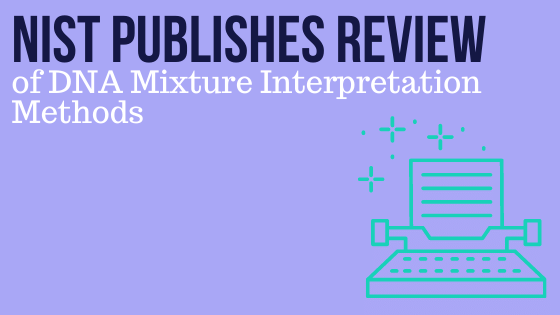Today’s blog is written by guest blogger, Rich Press. Reposted from the NIST blog with permission.
The National Institute of Standards and Technology (NIST) has published DNA Mixture Interpretation: A Scientific Foundation Review. This draft report, which will be open for public comment for 60 days before being published in final form, reviews the methods that forensic laboratories use to interpret evidence containing a mixture of DNA from two or more people.
NIST scientific foundation reviews document and evaluate the scientific basis for forensic methods. These reviews fill a need identified in a landmark 2009 study by the National Academy of Sciences, which found that many forensic disciplines lack a solid foundation in scientific research.
The NIST review states that currently “there is not enough publicly available data to enable an external and independent assessment of the degree of reliability of DNA mixture interpretation practices, including the use of probabilistic genotyping software (PGS) systems.”
PGS systems are used to perform complex statistical calculations when interpreting DNA mixtures. The report reviewed those systems as well as the larger workflows in which they are used.
The review identified many peer-reviewed studies of PGS systems, but most did not include the type of detailed data that would allow for an independent assessment of system performance. Forensic laboratories conduct internal studies to test their own systems, but most do not make the resulting data publicly available, partly out of privacy concerns surrounding the genetic data used in those studies.
The report specifies the types of data that would enable an independent assessment and shows how statistical methods could be used to assess performance if that data were available. The report also recommends that researchers and forensic laboratories publish this data in a way that will allow results from different studies to be more easily compared.
DNA profiling generally produces very reliable results when the evidence contains sufficient DNA from a single individual. The NIST report only addresses DNA mixtures, which can present much greater challenges.
Those challenges have increased in recent years with advancing technology. When DNA methods were first developed in the 1980s, labs needed the amount of DNA found in a dime-sized blood or semen stain to produce a genetic fingerprint. Today, they can get a genetic fingerprint from the “touch DNA” that a person leaves behind when handling doorknobs, firearms and other objects.
This increased sensitivity makes DNA useful for investigating a greater variety of crimes. But highly sensitive techniques often pick up mixtures of DNA from multiple people, some of whom may have had nothing to do with the crime being investigated.
“Estimating how many individuals contributed to a DNA mixture, distinguishing one person’s DNA from another and determining if the DNA is even relevant to the crime can be very challenging,” said NIST Fellow and lead author John Butler. “If not properly considered and communicated, these issues can lead to misunderstandings regarding the strength and relevance of the DNA evidence in a case.”
Not all DNA mixtures are difficult to interpret. Some may be relatively simple, while others may be too complex to reliably interpret at all. It depends on the specifics of the case, including how many people contributed to the mixture and the amount of DNA from each, among other things.
“Clearly, many DNA mixtures can be reliably interpreted,” Butler said. “But all scientific methods have limits, and from the sources we reviewed, it is not always clear where people are drawing the line and why.”
The report also emphasizes that, based on a review of the scientific literature, the DNA present on a piece of evidence may be unrelated to criminal activity and that experts should assess whether the DNA is relevant to the crime. This is especially important when analyzing very small amounts of DNA.
While conducting this review, the authors received input and feedback from 13 outside experts, including researchers and managers of forensic DNA laboratories. This report is the first of several scientific foundation reviews that NIST has undertaken in forensic science. Reviews of firearms examination, digital evidence and bitemark analysis are currently underway.
NIST scientific foundation reviews identify priorities for future research, help laboratories identify appropriate limitations on the use of forensic methods and suggest steps for moving the field forward. These reviews are conducted as part of NIST’s forensic science program, which works to strengthen forensic practice through research and improved standards. In 2018 Congress directed NIST to conduct these scientific reviews and appropriated funding for them.
Readers can submit comments on the draft report through Aug. 9, 2021. NIST will host a webinar about the draft report on July 21, 2021. Instructions for submitting comments and registration information for the webinar are available on the NIST website.
NIST promotes U.S. innovation and industrial competitiveness by advancing measurement science, standards and technology in ways that enhance economic security and improve our quality of life. To learn more about NIST, visit NIST.gov.
WOULD YOU LIKE TO SEE MORE ARTICLES LIKE THIS? SUBSCRIBE TO THE ISHI BLOG BELOW!
SUBSCRIBE NOW!


